Project Configuration Management: A Detailed Report on Printing
VerifiedAdded on 2023/06/10
|10
|1871
|274
Report
AI Summary
This report provides a comprehensive overview of project configuration management within a printing organization, focusing on configuration control, change management processes, and system overviews. It details the purpose and scope of configuration management, highlighting key elements such as change control boards, configuration items, and baseline identification (functional, design, development, and product baselines). The report also covers roles and responsibilities, change classifications, problem resolution tracking, and configuration account status. Furthermore, it addresses configuration management libraries, release management, configuration audits (functional and physical), and the tools required for effective project management. The importance of regular training for employees is emphasized, with a focus on providing the latest market products and technologies. This document serves as a guide for maintaining accounting status, verifying completeness, and ensuring the correctness of project items, offering valuable insights into optimizing printing operations and maintaining competitiveness.
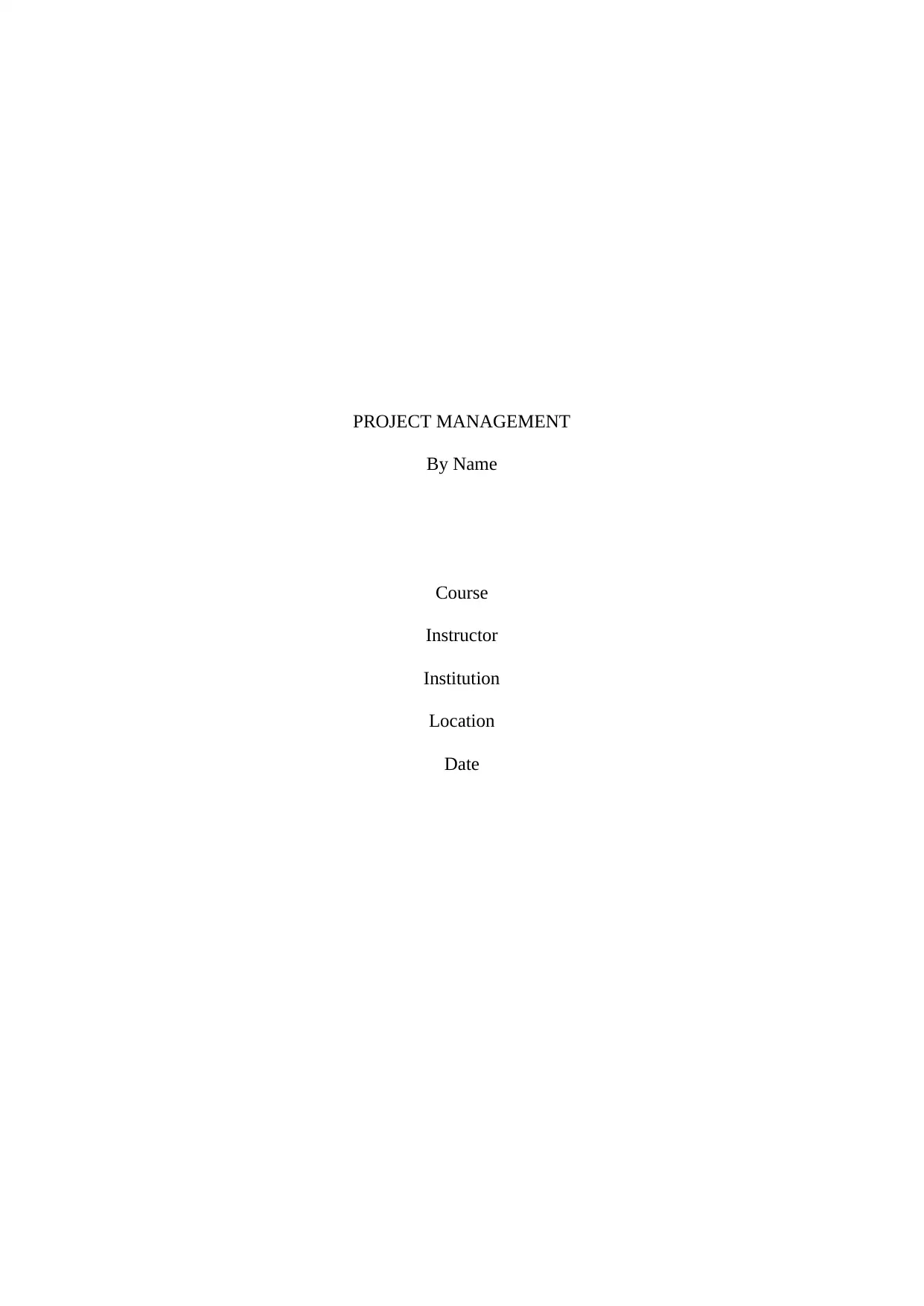
PROJECT MANAGEMENT
By Name
Course
Instructor
Institution
Location
Date
By Name
Course
Instructor
Institution
Location
Date
Paraphrase This Document
Need a fresh take? Get an instant paraphrase of this document with our AI Paraphraser
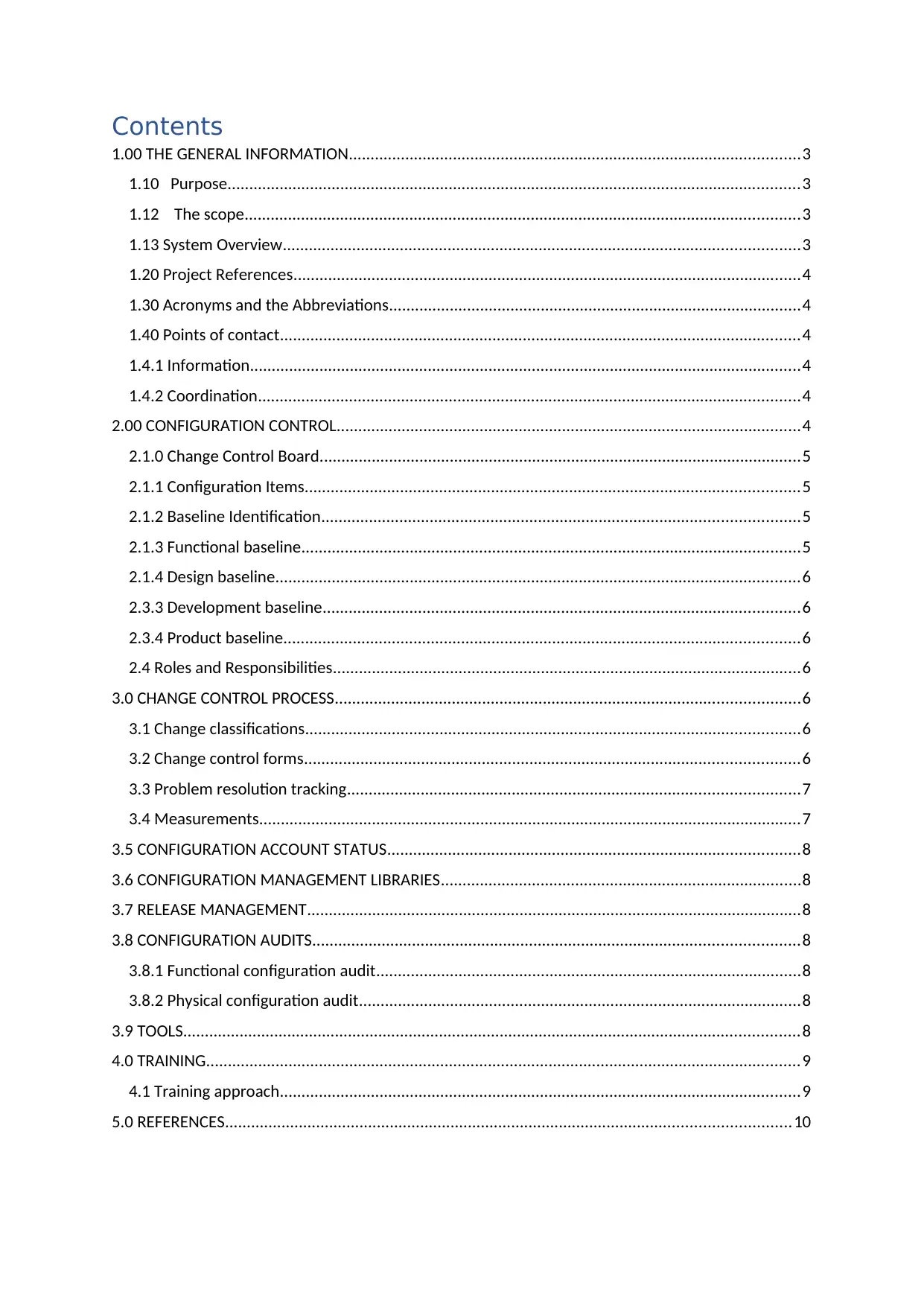
Contents
1.00 THE GENERAL INFORMATION........................................................................................................3
1.10 Purpose....................................................................................................................................3
1.12 The scope................................................................................................................................3
1.13 System Overview.......................................................................................................................3
1.20 Project References.....................................................................................................................4
1.30 Acronyms and the Abbreviations...............................................................................................4
1.40 Points of contact........................................................................................................................4
1.4.1 Information...............................................................................................................................4
1.4.2 Coordination.............................................................................................................................4
2.00 CONFIGURATION CONTROL...........................................................................................................4
2.1.0 Change Control Board...............................................................................................................5
2.1.1 Configuration Items..................................................................................................................5
2.1.2 Baseline Identification..............................................................................................................5
2.1.3 Functional baseline...................................................................................................................5
2.1.4 Design baseline.........................................................................................................................6
2.3.3 Development baseline..............................................................................................................6
2.3.4 Product baseline.......................................................................................................................6
2.4 Roles and Responsibilities............................................................................................................6
3.0 CHANGE CONTROL PROCESS...........................................................................................................6
3.1 Change classifications..................................................................................................................6
3.2 Change control forms..................................................................................................................6
3.3 Problem resolution tracking........................................................................................................7
3.4 Measurements.............................................................................................................................7
3.5 CONFIGURATION ACCOUNT STATUS...............................................................................................8
3.6 CONFIGURATION MANAGEMENT LIBRARIES...................................................................................8
3.7 RELEASE MANAGEMENT..................................................................................................................8
3.8 CONFIGURATION AUDITS................................................................................................................8
3.8.1 Functional configuration audit..................................................................................................8
3.8.2 Physical configuration audit......................................................................................................8
3.9 TOOLS..............................................................................................................................................8
4.0 TRAINING.........................................................................................................................................9
4.1 Training approach........................................................................................................................9
5.0 REFERENCES..................................................................................................................................10
1.00 THE GENERAL INFORMATION........................................................................................................3
1.10 Purpose....................................................................................................................................3
1.12 The scope................................................................................................................................3
1.13 System Overview.......................................................................................................................3
1.20 Project References.....................................................................................................................4
1.30 Acronyms and the Abbreviations...............................................................................................4
1.40 Points of contact........................................................................................................................4
1.4.1 Information...............................................................................................................................4
1.4.2 Coordination.............................................................................................................................4
2.00 CONFIGURATION CONTROL...........................................................................................................4
2.1.0 Change Control Board...............................................................................................................5
2.1.1 Configuration Items..................................................................................................................5
2.1.2 Baseline Identification..............................................................................................................5
2.1.3 Functional baseline...................................................................................................................5
2.1.4 Design baseline.........................................................................................................................6
2.3.3 Development baseline..............................................................................................................6
2.3.4 Product baseline.......................................................................................................................6
2.4 Roles and Responsibilities............................................................................................................6
3.0 CHANGE CONTROL PROCESS...........................................................................................................6
3.1 Change classifications..................................................................................................................6
3.2 Change control forms..................................................................................................................6
3.3 Problem resolution tracking........................................................................................................7
3.4 Measurements.............................................................................................................................7
3.5 CONFIGURATION ACCOUNT STATUS...............................................................................................8
3.6 CONFIGURATION MANAGEMENT LIBRARIES...................................................................................8
3.7 RELEASE MANAGEMENT..................................................................................................................8
3.8 CONFIGURATION AUDITS................................................................................................................8
3.8.1 Functional configuration audit..................................................................................................8
3.8.2 Physical configuration audit......................................................................................................8
3.9 TOOLS..............................................................................................................................................8
4.0 TRAINING.........................................................................................................................................9
4.1 Training approach........................................................................................................................9
5.0 REFERENCES..................................................................................................................................10
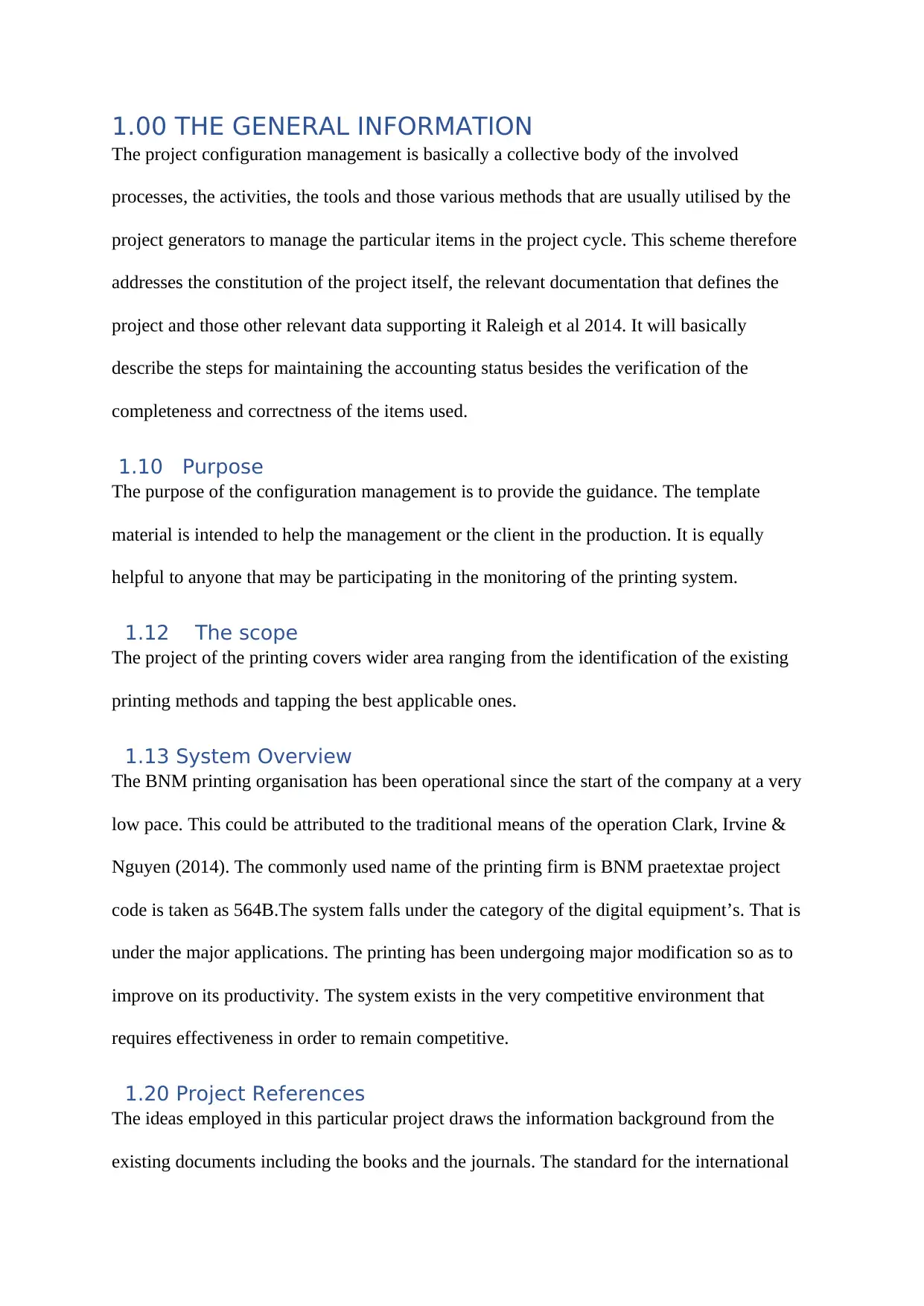
1.00 THE GENERAL INFORMATION
The project configuration management is basically a collective body of the involved
processes, the activities, the tools and those various methods that are usually utilised by the
project generators to manage the particular items in the project cycle. This scheme therefore
addresses the constitution of the project itself, the relevant documentation that defines the
project and those other relevant data supporting it Raleigh et al 2014. It will basically
describe the steps for maintaining the accounting status besides the verification of the
completeness and correctness of the items used.
1.10 Purpose
The purpose of the configuration management is to provide the guidance. The template
material is intended to help the management or the client in the production. It is equally
helpful to anyone that may be participating in the monitoring of the printing system.
1.12 The scope
The project of the printing covers wider area ranging from the identification of the existing
printing methods and tapping the best applicable ones.
1.13 System Overview
The BNM printing organisation has been operational since the start of the company at a very
low pace. This could be attributed to the traditional means of the operation Clark, Irvine &
Nguyen (2014). The commonly used name of the printing firm is BNM praetextae project
code is taken as 564B.The system falls under the category of the digital equipment’s. That is
under the major applications. The printing has been undergoing major modification so as to
improve on its productivity. The system exists in the very competitive environment that
requires effectiveness in order to remain competitive.
1.20 Project References
The ideas employed in this particular project draws the information background from the
existing documents including the books and the journals. The standard for the international
The project configuration management is basically a collective body of the involved
processes, the activities, the tools and those various methods that are usually utilised by the
project generators to manage the particular items in the project cycle. This scheme therefore
addresses the constitution of the project itself, the relevant documentation that defines the
project and those other relevant data supporting it Raleigh et al 2014. It will basically
describe the steps for maintaining the accounting status besides the verification of the
completeness and correctness of the items used.
1.10 Purpose
The purpose of the configuration management is to provide the guidance. The template
material is intended to help the management or the client in the production. It is equally
helpful to anyone that may be participating in the monitoring of the printing system.
1.12 The scope
The project of the printing covers wider area ranging from the identification of the existing
printing methods and tapping the best applicable ones.
1.13 System Overview
The BNM printing organisation has been operational since the start of the company at a very
low pace. This could be attributed to the traditional means of the operation Clark, Irvine &
Nguyen (2014). The commonly used name of the printing firm is BNM praetextae project
code is taken as 564B.The system falls under the category of the digital equipment’s. That is
under the major applications. The printing has been undergoing major modification so as to
improve on its productivity. The system exists in the very competitive environment that
requires effectiveness in order to remain competitive.
1.20 Project References
The ideas employed in this particular project draws the information background from the
existing documents including the books and the journals. The standard for the international
⊘ This is a preview!⊘
Do you want full access?
Subscribe today to unlock all pages.

Trusted by 1+ million students worldwide
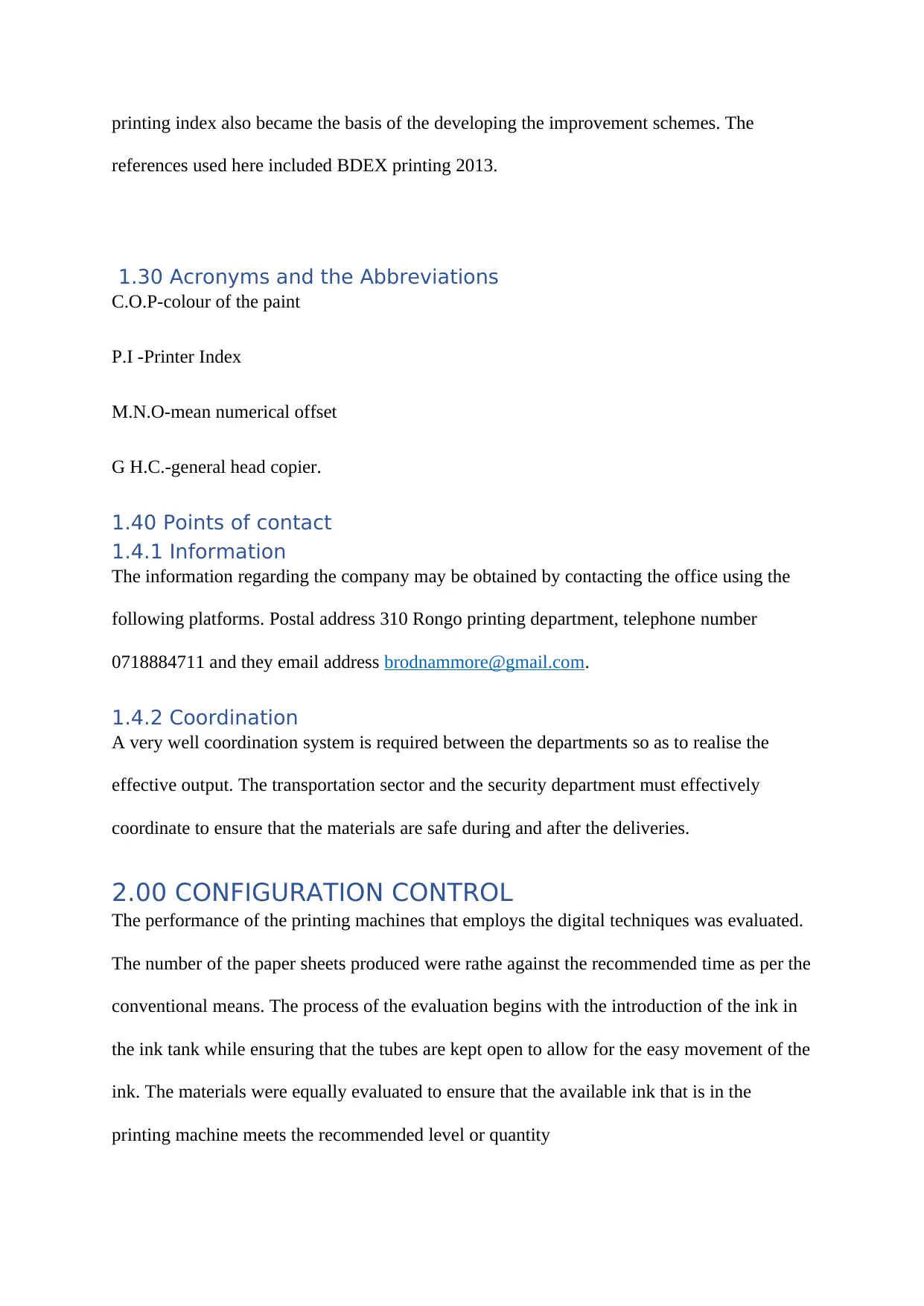
printing index also became the basis of the developing the improvement schemes. The
references used here included BDEX printing 2013.
1.30 Acronyms and the Abbreviations
C.O.P-colour of the paint
P.I -Printer Index
M.N.O-mean numerical offset
G H.C.-general head copier.
1.40 Points of contact
1.4.1 Information
The information regarding the company may be obtained by contacting the office using the
following platforms. Postal address 310 Rongo printing department, telephone number
0718884711 and they email address brodnammore@gmail.com.
1.4.2 Coordination
A very well coordination system is required between the departments so as to realise the
effective output. The transportation sector and the security department must effectively
coordinate to ensure that the materials are safe during and after the deliveries.
2.00 CONFIGURATION CONTROL
The performance of the printing machines that employs the digital techniques was evaluated.
The number of the paper sheets produced were rathe against the recommended time as per the
conventional means. The process of the evaluation begins with the introduction of the ink in
the ink tank while ensuring that the tubes are kept open to allow for the easy movement of the
ink. The materials were equally evaluated to ensure that the available ink that is in the
printing machine meets the recommended level or quantity
references used here included BDEX printing 2013.
1.30 Acronyms and the Abbreviations
C.O.P-colour of the paint
P.I -Printer Index
M.N.O-mean numerical offset
G H.C.-general head copier.
1.40 Points of contact
1.4.1 Information
The information regarding the company may be obtained by contacting the office using the
following platforms. Postal address 310 Rongo printing department, telephone number
0718884711 and they email address brodnammore@gmail.com.
1.4.2 Coordination
A very well coordination system is required between the departments so as to realise the
effective output. The transportation sector and the security department must effectively
coordinate to ensure that the materials are safe during and after the deliveries.
2.00 CONFIGURATION CONTROL
The performance of the printing machines that employs the digital techniques was evaluated.
The number of the paper sheets produced were rathe against the recommended time as per the
conventional means. The process of the evaluation begins with the introduction of the ink in
the ink tank while ensuring that the tubes are kept open to allow for the easy movement of the
ink. The materials were equally evaluated to ensure that the available ink that is in the
printing machine meets the recommended level or quantity
Paraphrase This Document
Need a fresh take? Get an instant paraphrase of this document with our AI Paraphraser
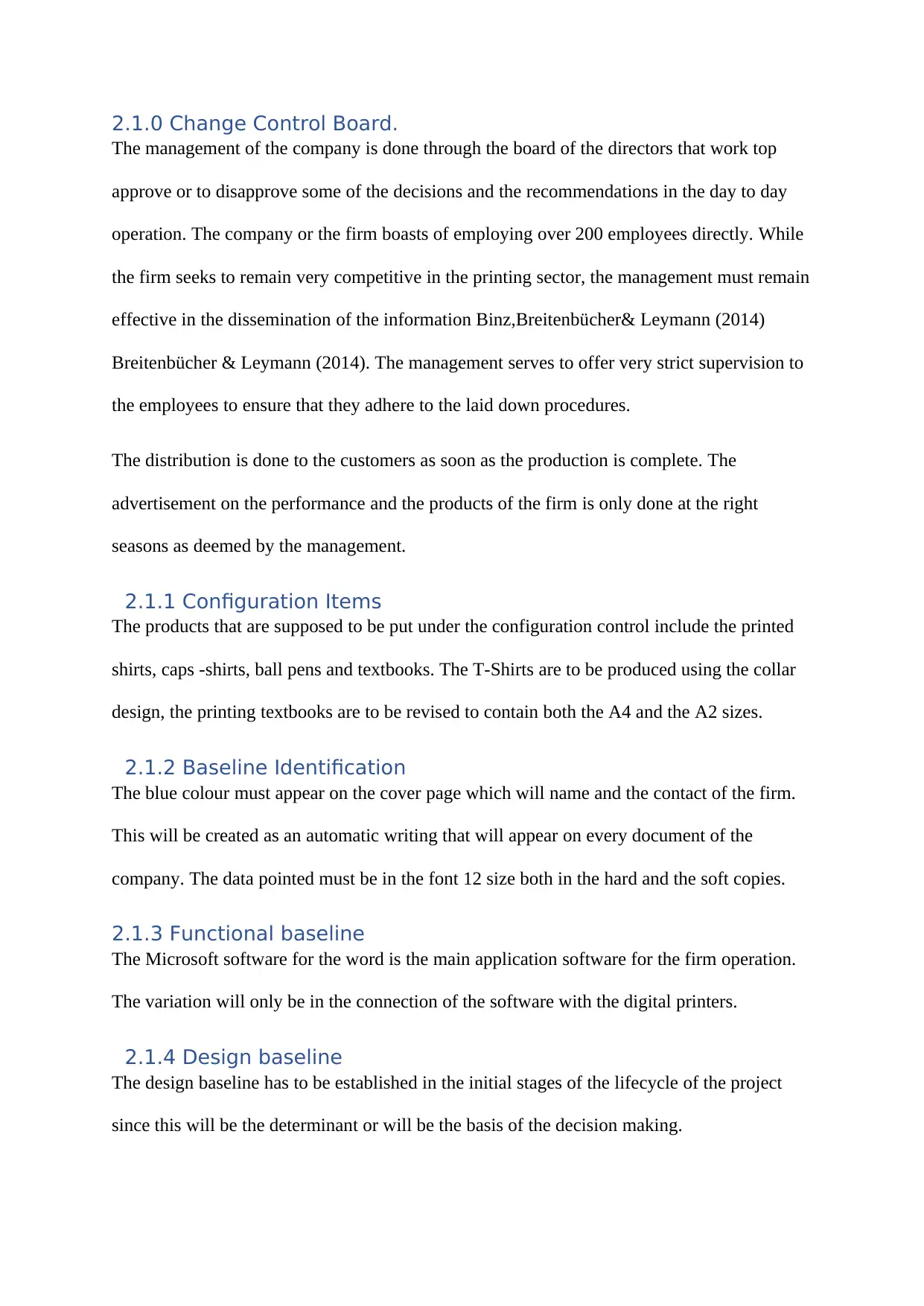
2.1.0 Change Control Board.
The management of the company is done through the board of the directors that work top
approve or to disapprove some of the decisions and the recommendations in the day to day
operation. The company or the firm boasts of employing over 200 employees directly. While
the firm seeks to remain very competitive in the printing sector, the management must remain
effective in the dissemination of the information Binz,Breitenbücher& Leymann (2014)
Breitenbücher & Leymann (2014). The management serves to offer very strict supervision to
the employees to ensure that they adhere to the laid down procedures.
The distribution is done to the customers as soon as the production is complete. The
advertisement on the performance and the products of the firm is only done at the right
seasons as deemed by the management.
2.1.1 Configuration Items
The products that are supposed to be put under the configuration control include the printed
shirts, caps -shirts, ball pens and textbooks. The T-Shirts are to be produced using the collar
design, the printing textbooks are to be revised to contain both the A4 and the A2 sizes.
2.1.2 Baseline Identification
The blue colour must appear on the cover page which will name and the contact of the firm.
This will be created as an automatic writing that will appear on every document of the
company. The data pointed must be in the font 12 size both in the hard and the soft copies.
2.1.3 Functional baseline
The Microsoft software for the word is the main application software for the firm operation.
The variation will only be in the connection of the software with the digital printers.
2.1.4 Design baseline
The design baseline has to be established in the initial stages of the lifecycle of the project
since this will be the determinant or will be the basis of the decision making.
The management of the company is done through the board of the directors that work top
approve or to disapprove some of the decisions and the recommendations in the day to day
operation. The company or the firm boasts of employing over 200 employees directly. While
the firm seeks to remain very competitive in the printing sector, the management must remain
effective in the dissemination of the information Binz,Breitenbücher& Leymann (2014)
Breitenbücher & Leymann (2014). The management serves to offer very strict supervision to
the employees to ensure that they adhere to the laid down procedures.
The distribution is done to the customers as soon as the production is complete. The
advertisement on the performance and the products of the firm is only done at the right
seasons as deemed by the management.
2.1.1 Configuration Items
The products that are supposed to be put under the configuration control include the printed
shirts, caps -shirts, ball pens and textbooks. The T-Shirts are to be produced using the collar
design, the printing textbooks are to be revised to contain both the A4 and the A2 sizes.
2.1.2 Baseline Identification
The blue colour must appear on the cover page which will name and the contact of the firm.
This will be created as an automatic writing that will appear on every document of the
company. The data pointed must be in the font 12 size both in the hard and the soft copies.
2.1.3 Functional baseline
The Microsoft software for the word is the main application software for the firm operation.
The variation will only be in the connection of the software with the digital printers.
2.1.4 Design baseline
The design baseline has to be established in the initial stages of the lifecycle of the project
since this will be the determinant or will be the basis of the decision making.
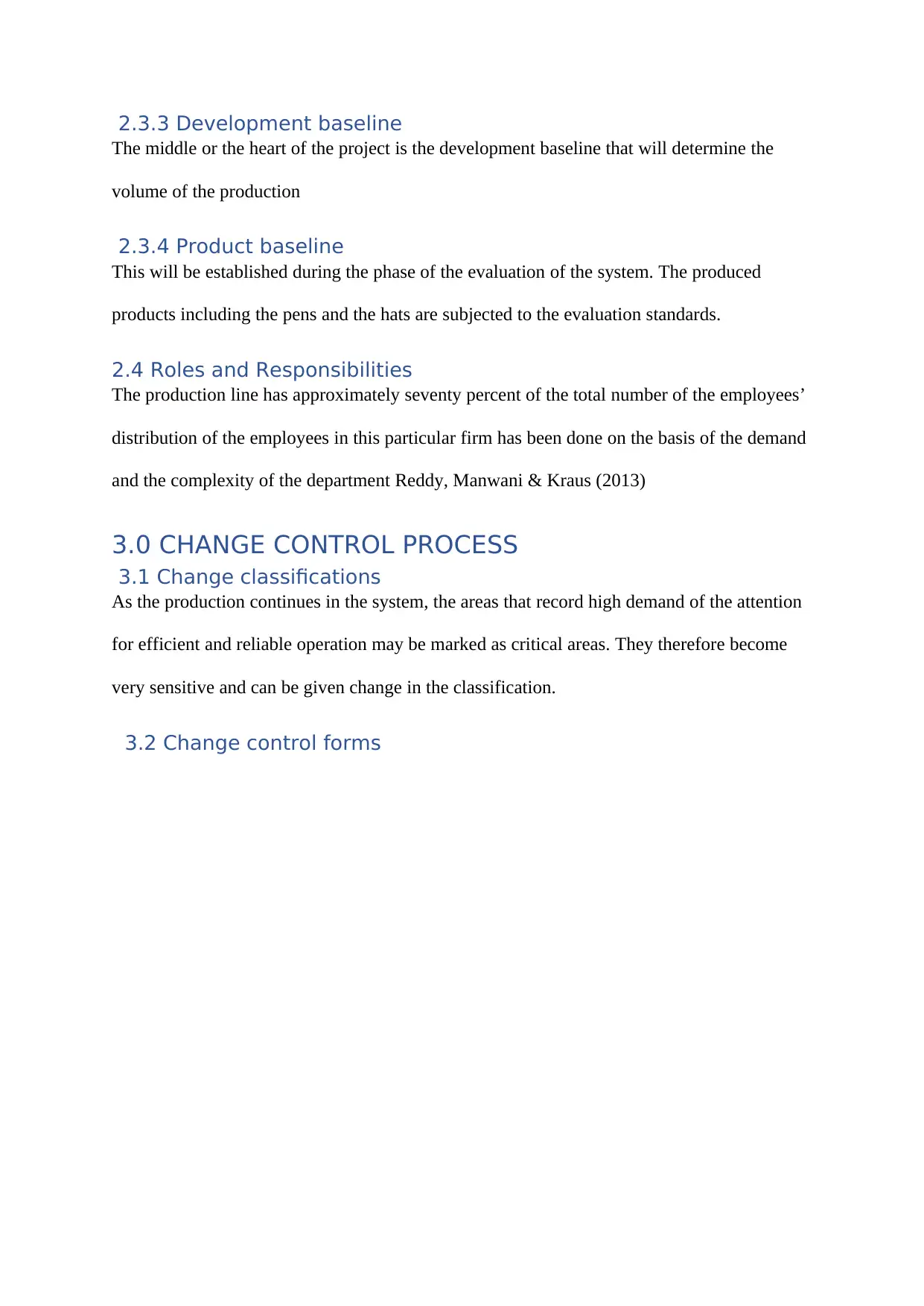
2.3.3 Development baseline
The middle or the heart of the project is the development baseline that will determine the
volume of the production
2.3.4 Product baseline
This will be established during the phase of the evaluation of the system. The produced
products including the pens and the hats are subjected to the evaluation standards.
2.4 Roles and Responsibilities
The production line has approximately seventy percent of the total number of the employees’
distribution of the employees in this particular firm has been done on the basis of the demand
and the complexity of the department Reddy, Manwani & Kraus (2013)
3.0 CHANGE CONTROL PROCESS
3.1 Change classifications
As the production continues in the system, the areas that record high demand of the attention
for efficient and reliable operation may be marked as critical areas. They therefore become
very sensitive and can be given change in the classification.
3.2 Change control forms
The middle or the heart of the project is the development baseline that will determine the
volume of the production
2.3.4 Product baseline
This will be established during the phase of the evaluation of the system. The produced
products including the pens and the hats are subjected to the evaluation standards.
2.4 Roles and Responsibilities
The production line has approximately seventy percent of the total number of the employees’
distribution of the employees in this particular firm has been done on the basis of the demand
and the complexity of the department Reddy, Manwani & Kraus (2013)
3.0 CHANGE CONTROL PROCESS
3.1 Change classifications
As the production continues in the system, the areas that record high demand of the attention
for efficient and reliable operation may be marked as critical areas. They therefore become
very sensitive and can be given change in the classification.
3.2 Change control forms
⊘ This is a preview!⊘
Do you want full access?
Subscribe today to unlock all pages.

Trusted by 1+ million students worldwide

Change control forms
The changes made to the departments as a way of respond ng to the emergencies must extent
down to the respective forms of the operation.
3.3 Problem resolution tracking
The major parameters of the problems will be fed into the system using the relevant
software’s corresponding results are then taken into the account for further analysis.
3.4 Measurements
The exact quantities of the products required, their specific sizes and the masses are taken for
the sake of data confirmation.
The changes made to the departments as a way of respond ng to the emergencies must extent
down to the respective forms of the operation.
3.3 Problem resolution tracking
The major parameters of the problems will be fed into the system using the relevant
software’s corresponding results are then taken into the account for further analysis.
3.4 Measurements
The exact quantities of the products required, their specific sizes and the masses are taken for
the sake of data confirmation.
Paraphrase This Document
Need a fresh take? Get an instant paraphrase of this document with our AI Paraphraser
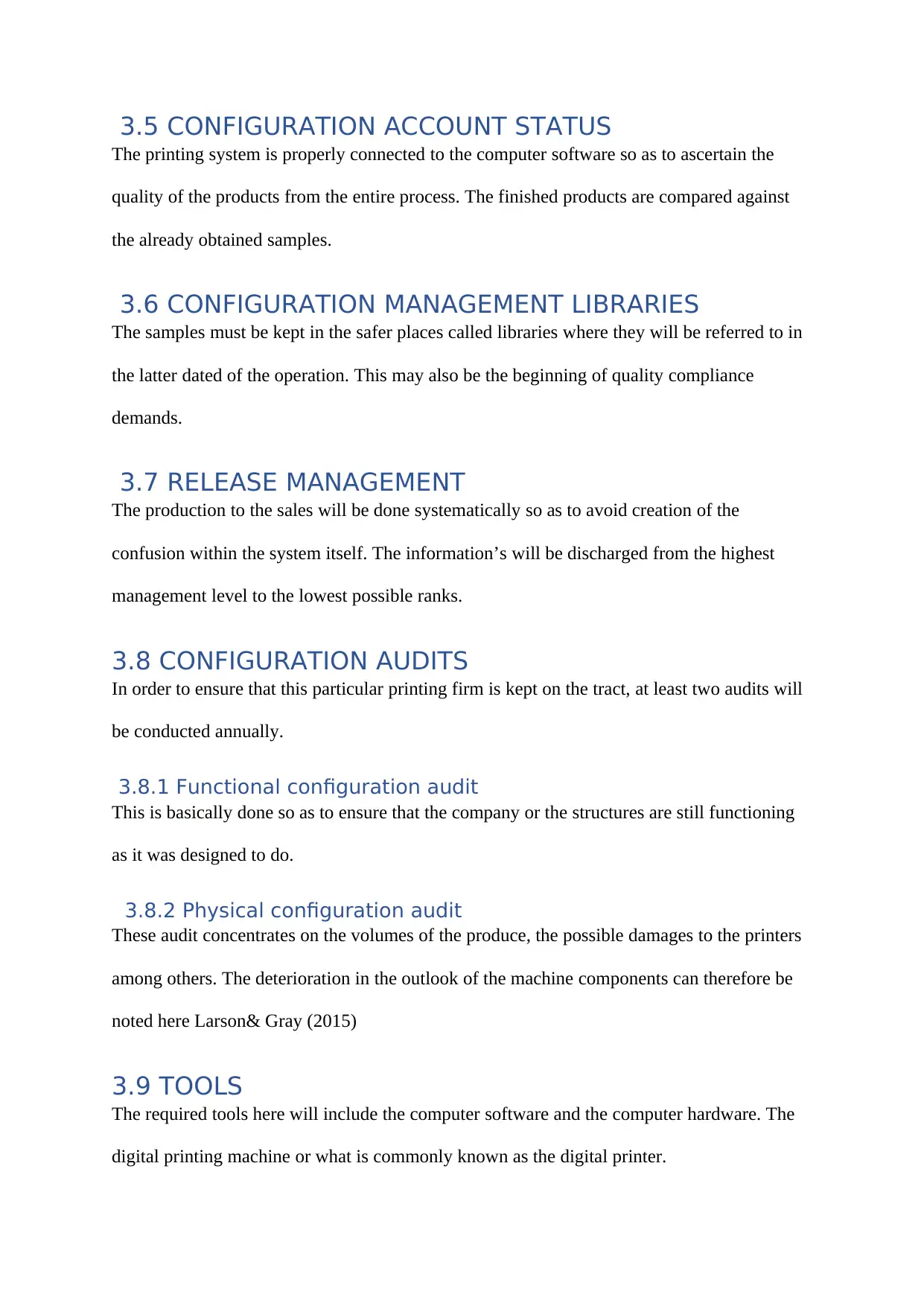
3.5 CONFIGURATION ACCOUNT STATUS
The printing system is properly connected to the computer software so as to ascertain the
quality of the products from the entire process. The finished products are compared against
the already obtained samples.
3.6 CONFIGURATION MANAGEMENT LIBRARIES
The samples must be kept in the safer places called libraries where they will be referred to in
the latter dated of the operation. This may also be the beginning of quality compliance
demands.
3.7 RELEASE MANAGEMENT
The production to the sales will be done systematically so as to avoid creation of the
confusion within the system itself. The information’s will be discharged from the highest
management level to the lowest possible ranks.
3.8 CONFIGURATION AUDITS
In order to ensure that this particular printing firm is kept on the tract, at least two audits will
be conducted annually.
3.8.1 Functional configuration audit
This is basically done so as to ensure that the company or the structures are still functioning
as it was designed to do.
3.8.2 Physical configuration audit
These audit concentrates on the volumes of the produce, the possible damages to the printers
among others. The deterioration in the outlook of the machine components can therefore be
noted here Larson& Gray (2015)
3.9 TOOLS
The required tools here will include the computer software and the computer hardware. The
digital printing machine or what is commonly known as the digital printer.
The printing system is properly connected to the computer software so as to ascertain the
quality of the products from the entire process. The finished products are compared against
the already obtained samples.
3.6 CONFIGURATION MANAGEMENT LIBRARIES
The samples must be kept in the safer places called libraries where they will be referred to in
the latter dated of the operation. This may also be the beginning of quality compliance
demands.
3.7 RELEASE MANAGEMENT
The production to the sales will be done systematically so as to avoid creation of the
confusion within the system itself. The information’s will be discharged from the highest
management level to the lowest possible ranks.
3.8 CONFIGURATION AUDITS
In order to ensure that this particular printing firm is kept on the tract, at least two audits will
be conducted annually.
3.8.1 Functional configuration audit
This is basically done so as to ensure that the company or the structures are still functioning
as it was designed to do.
3.8.2 Physical configuration audit
These audit concentrates on the volumes of the produce, the possible damages to the printers
among others. The deterioration in the outlook of the machine components can therefore be
noted here Larson& Gray (2015)
3.9 TOOLS
The required tools here will include the computer software and the computer hardware. The
digital printing machine or what is commonly known as the digital printer.
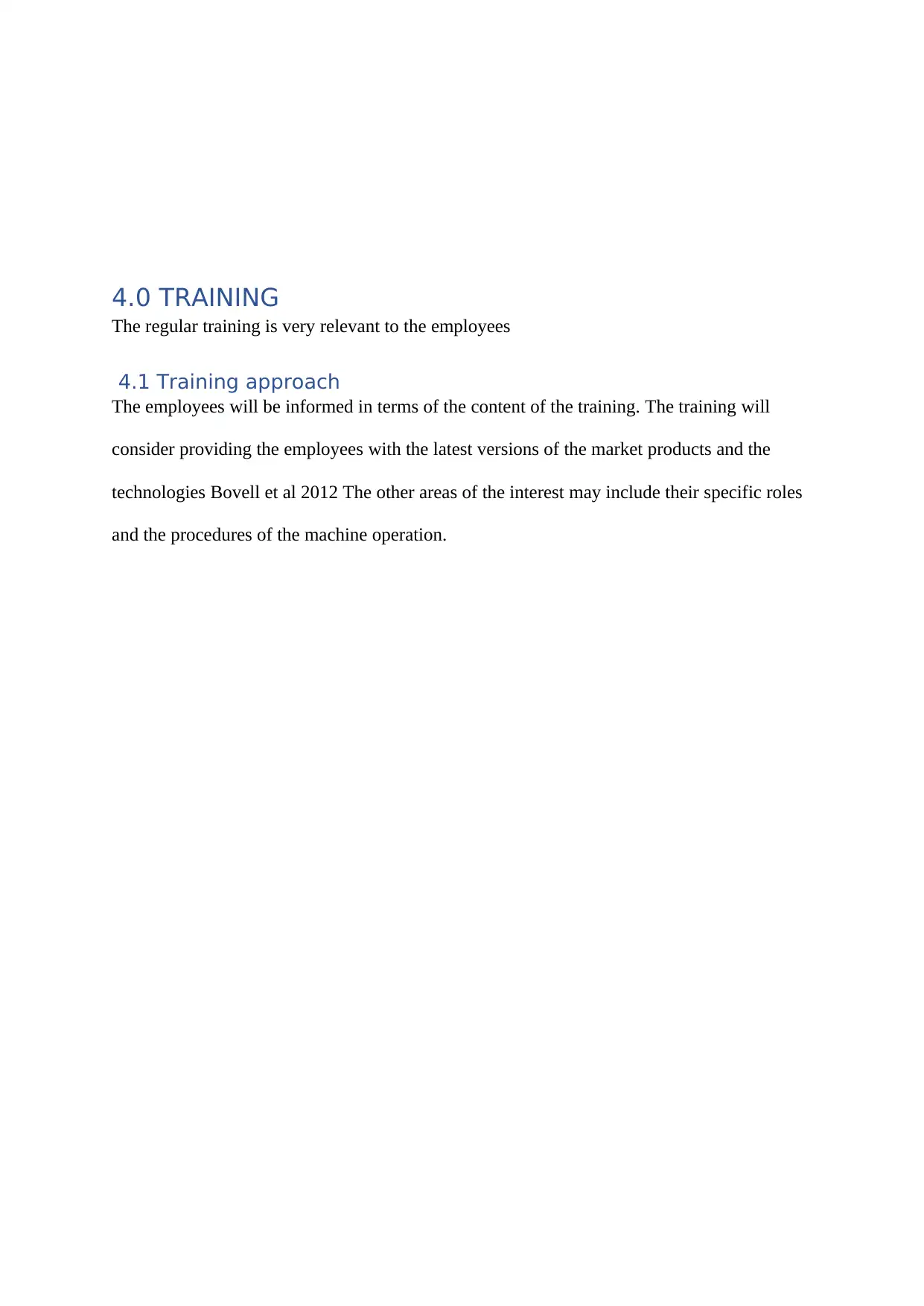
4.0 TRAINING
The regular training is very relevant to the employees
4.1 Training approach
The employees will be informed in terms of the content of the training. The training will
consider providing the employees with the latest versions of the market products and the
technologies Bovell et al 2012 The other areas of the interest may include their specific roles
and the procedures of the machine operation.
The regular training is very relevant to the employees
4.1 Training approach
The employees will be informed in terms of the content of the training. The training will
consider providing the employees with the latest versions of the market products and the
technologies Bovell et al 2012 The other areas of the interest may include their specific roles
and the procedures of the machine operation.
⊘ This is a preview!⊘
Do you want full access?
Subscribe today to unlock all pages.

Trusted by 1+ million students worldwide
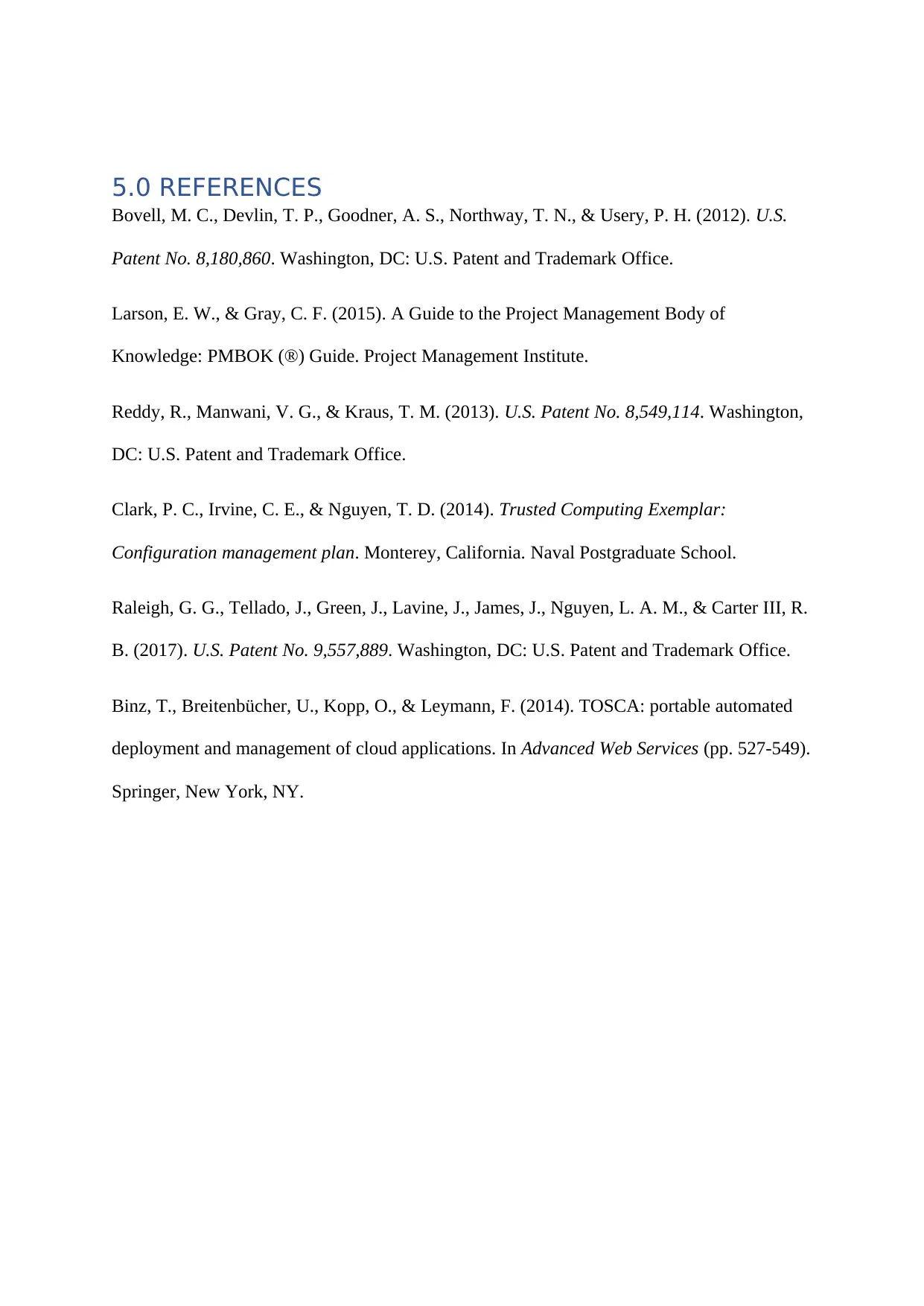
5.0 REFERENCES
Bovell, M. C., Devlin, T. P., Goodner, A. S., Northway, T. N., & Usery, P. H. (2012). U.S.
Patent No. 8,180,860. Washington, DC: U.S. Patent and Trademark Office.
Larson, E. W., & Gray, C. F. (2015). A Guide to the Project Management Body of
Knowledge: PMBOK (®) Guide. Project Management Institute.
Reddy, R., Manwani, V. G., & Kraus, T. M. (2013). U.S. Patent No. 8,549,114. Washington,
DC: U.S. Patent and Trademark Office.
Clark, P. C., Irvine, C. E., & Nguyen, T. D. (2014). Trusted Computing Exemplar:
Configuration management plan. Monterey, California. Naval Postgraduate School.
Raleigh, G. G., Tellado, J., Green, J., Lavine, J., James, J., Nguyen, L. A. M., & Carter III, R.
B. (2017). U.S. Patent No. 9,557,889. Washington, DC: U.S. Patent and Trademark Office.
Binz, T., Breitenbücher, U., Kopp, O., & Leymann, F. (2014). TOSCA: portable automated
deployment and management of cloud applications. In Advanced Web Services (pp. 527-549).
Springer, New York, NY.
Bovell, M. C., Devlin, T. P., Goodner, A. S., Northway, T. N., & Usery, P. H. (2012). U.S.
Patent No. 8,180,860. Washington, DC: U.S. Patent and Trademark Office.
Larson, E. W., & Gray, C. F. (2015). A Guide to the Project Management Body of
Knowledge: PMBOK (®) Guide. Project Management Institute.
Reddy, R., Manwani, V. G., & Kraus, T. M. (2013). U.S. Patent No. 8,549,114. Washington,
DC: U.S. Patent and Trademark Office.
Clark, P. C., Irvine, C. E., & Nguyen, T. D. (2014). Trusted Computing Exemplar:
Configuration management plan. Monterey, California. Naval Postgraduate School.
Raleigh, G. G., Tellado, J., Green, J., Lavine, J., James, J., Nguyen, L. A. M., & Carter III, R.
B. (2017). U.S. Patent No. 9,557,889. Washington, DC: U.S. Patent and Trademark Office.
Binz, T., Breitenbücher, U., Kopp, O., & Leymann, F. (2014). TOSCA: portable automated
deployment and management of cloud applications. In Advanced Web Services (pp. 527-549).
Springer, New York, NY.
1 out of 10
Your All-in-One AI-Powered Toolkit for Academic Success.
+13062052269
info@desklib.com
Available 24*7 on WhatsApp / Email
![[object Object]](/_next/static/media/star-bottom.7253800d.svg)
Unlock your academic potential
Copyright © 2020–2025 A2Z Services. All Rights Reserved. Developed and managed by ZUCOL.